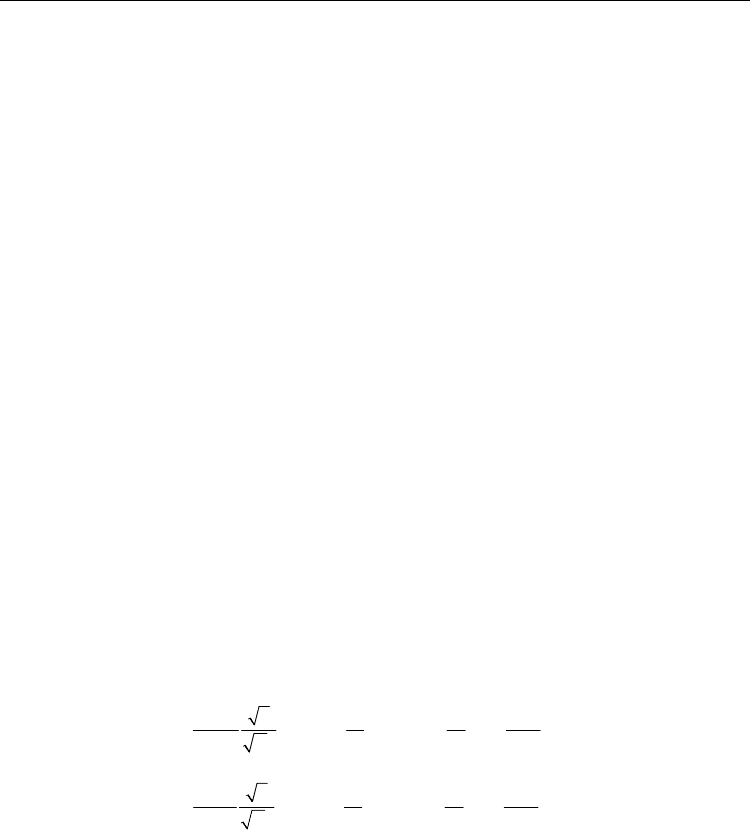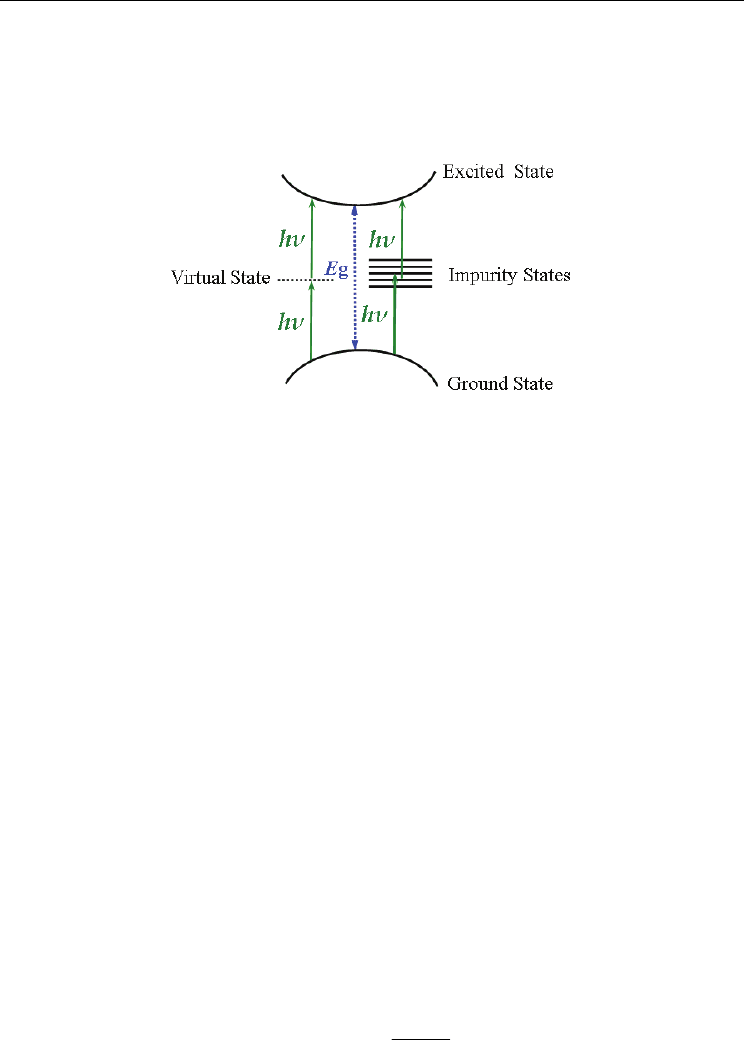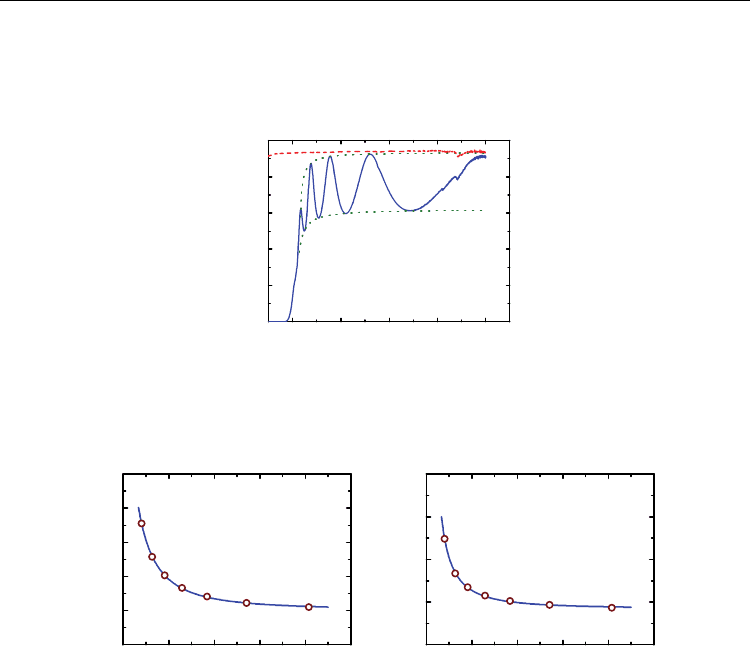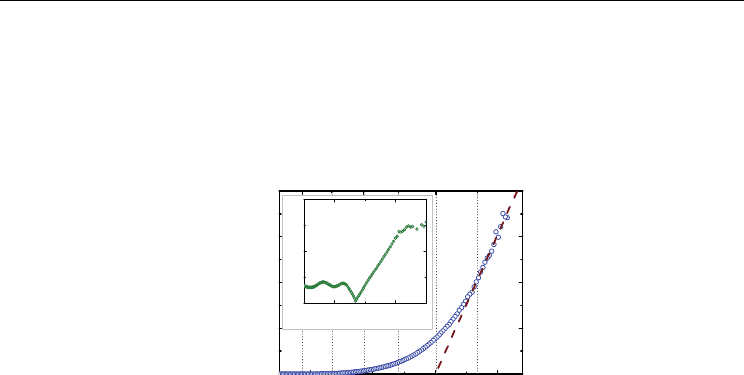Lallart M. (ed.) Ferroelectrics - Physical Effects
Подождите немного. Документ загружается.


Linear and Nonlinear Optical Properties of Ferroelectric Thin Films
509
(3)
2
2
00
3Re[ ]
4
n
cn
χ
ε
=
, (5)
(3)
2
2
00
3Im[ ]
2 cn
πχ
α
ε
λ
= , (6)
where n
2
and
α
2
take the units of m
2
/W and m/W, respectively. And
λ
is the wavelength of
laser in vacuum.
3. Physical mechanisms of optical nonlinearities in ferroelectric thin films
Optical nonlinear response of the ferroelectric thin film partly depends on the laser
characteristics, in particular, on the laser pulse duration and on the excitation wavelength,
and partly on the material itself. The optical nonlinearities usually fall in two main
categories: the instantaneous and accumulative nonlinear effects. If the nonlinear response
time is much less than the pulse duration, the nonlinearity can be regarded justifiably as
responding instantaneously to optical pulses. On the contrary, the accumulative
nonlinearities may occur in a time scale longer than the pulse duration. Besides, the
instantaneous nonlinearity (for instance, two-photon absorption and optical Kerr effect) is
independent of the the laser pulse duration, whereas the accumulative nonlinearity depends
strongly on the pulse duration. Examples of such accumulative nonlinearities include
excited-state nonlinearity, thermal effect, and free-carrier nonlinearity. The simultaneous
accumulative nonlinearities and inherent nonlinear effects lead to the huge difference of the
measured nonlinear response on a wide range of time scales.
3.1 Nonlinear absorption
In general, nonlinear absorption in ferroelectric thin films can be caused by two-photon
absorption, three-photon absorption, or saturable absorption. When the excitation photon
energy and the bandgap of the film fulfil the multiphoton absorption requirement [(n-
1)hν<E
g
<nhν] (here n is an integer. n=2 and 3 for two- and three-photon absorption,
respectively), the material simultaneous absorbs n identical photons and promotes an
electron from the ground state of a system to a higher-lying state by virtual intermediate
states. This process is referred to a one-step n-photon absorption and mainly contributes to
the absorptive nonlinearity of most ferroelectric films. When the excitation wavelength is
close to the resonance absorption band, the transmittance of materials increases with
increasing optical intensity. This is the well-known saturable absorption. Accordingly, the
material has a negative nonlinear absorption coefficient.
3.2 Nonlinear refraction
The physical mechanisms of nonlinear refraction in the ferroelectric thin films mainly involve
thermal contribution, optical electrostriction, population redistribution, and electronic Kerr
effect. The thermal heat leads to refractive index changes via the thermal-optic effect. The
nonlinearity originating from thermal effect will give rise to the negative nonlinear refraction.
In general, the thermal contribution has a very slow response time (nanosecond or longer). On
the picosecond and femtosecond time scales, the thermal contribution to the change of the
refractive index can be ignored for it is much smaller than the electronic contribution. Optical

Ferroelectrics – Physical Effects
510
electrostriction is a phenomenon that the inhomogeneous optical field produces a force on the
molecules or atoms comprising a system resulting in an increase of the refractive index locally.
This effect has the characteristic response time of nanosecond order. When the electron occurs
the real transition from the ground state of a system to a excited state by absorbing the single
photon or two indential photons, electrons will occupy real excited states for a finite period of
time. This process is called a population redistribution and mainly contributes the whole
refractive nonlinearity of ferroelectric films in the picosecond regime. The electronic Kerr effect
arises from a distortion of the electron cloud about atom or molecule by the optical field. This
process is very fast, with typical response time of tens of femtoseconds. The electronic Kerr
effect is the main mechanism of the refractive nonlinearity in the femtosecond time scale.
3.3 Accumulative nonlinearity caused by the defect
For many cases, the observed absorptive nonlinearity of ferroelectric thin films is the two-
photon absorption type process. Moreover, the measured two-photon absorption coefficient
strongly depends on the laser pulse duration (see Table 1). This two-photon type
nonlinearity originates from two-photon as well as two-step absorptions. The two-step
absorption is attributed to the introduction of electronic levels within the energy bandgap
due to the defects (Liu et al., 2006, Ambika et al., 2009, Yang et al., 2009).
The photodynamic process in ferroelectrics with impurities is illustrated in Fig. 1. Electrons
in the ground state could be promoted to the excited state and impurity states based on two-
and one-photon absorption, respectively. The electrons in impurity states may be promoted
to the excited state by absorbing another identical photon, resulting in two-step two-photon
absorption. At the same time, one-photon absorption by impurity levels populates new
electronic state. This significant population redistribution produces an additional change in
the refractive index, leading to the accumulative nonlinear refraction effect. This
accumulative nonlinearity is a cubic effect in nature and strongly depends on the pulse
duration of laser. Similar to the procedure for analyzing the excited-state nonlinearity
induced by one- and two-photon absorption (Gu et al., 2008b and 2010), the effective third-
order nonlinear absorption and refraction coefficients arising from the two-step two-photon
absorption can be expressed as
22
imp 0
imp
2
22
imp
2
exp( ) exp( ) exp( )
t
tttt
dt dt
h
σα
α
ντττ
πτ
+∞
−∞ −∞
⎧
⎫
′′
−
⎪
⎪
′
=−−
⎨
⎬
⎪
⎪
⎩⎭
∫∫
, (7)
22
imp 0
imp
2
22
imp
2
exp( ) exp( ) exp( )
t
tttt
ndtdt
h
ηα
ντττ
πτ
+∞
−∞ −∞
⎧
⎫
′′
−
⎪
⎪
′
=−−
⎨
⎬
⎪
⎪
⎩⎭
∫∫
. (8)
Here
σ
imp
and
η
imp
are the effective absorptive and refractive cross-sections of the impurity
state, respectively.
τ
is the half-width at e
-1
of the maximum for the pulse duration of the
Gaussian laser. And
τ
imp
is the lifetime of the impurity state.
4. Characterizing techniques to determine the films’ linear and nonlinear
optical properties
In general, the ferroelectric thin film is deposited on the transparent substrate. The
fundamental optical constants (the linear absorption coefficient, linear refraction index, and
bandgap energy) of the thin film could be determined by various methods, such as the

Linear and Nonlinear Optical Properties of Ferroelectric Thin Films
511
prism-film coupler technique, spectroscopic ellipsometry, and reflectivity spectrum
measurement. Among these methods, the transmittance spectrum using the envelope
technique is a simple straightforward approach. To characterize the absorptive and
refractive nonlinearities of ferroelectric films, the single-beam Z-scan technique is
extensively adopted.
Fig. 1. Schematic diagram of one- and two-step two-photon absorption in ferroelectrics with
the defects.
4.1 Linear optical parameters obtained from the transmittance spectrum using the
envelope technique
The practical situation for a thin film on a thick finite transparent substrate is illustrated in
Fig. 2. The film has a thickness of d, a linear refractive index n
0
, and a linear absorption
coefficient
α
0
. The transparent substrate has a thickness several orders of magnitude larger
than d and has an index of refraction n
0
sub
and an absorption coefficient
α
0
sub
≈0. The index of
the surrounding air is equal to 1.
Taking into account all the multiple reflections at the three interfaces, the rigorous
transmission could be devised (Swanepoel, 1983). Subsequently, it is easy to simulate the
transmittance spectrum from the given parameters (d, n
0
,
α
0
, d
sub
, and n
0
sub
). The oscillations
in the transmittance are a result of the interference between the air-film and film-substrate
interface (for example, see Fig. 4). In contrast, in practical applications for determining the
optical constants of films, one must employ the transmittance spectrum to evaluate the
optical constants. The treatment of such an inverse problem is relatively difficult. From the
measured transmittance spectrum, the extremes of the interference fringes are obtained (see
dotted lines in Fig. 4). Based on the envelope technique of the transmittance spectrum, the
optical constants (d, n
0
, and
α
0
) could be estimated (Swanepoel, 1983).
The refractive index as a function of wavelength in the interband-transition region can be
modelled based on dipole oscillators. This theory assumes that the material is composed of a
series of independent oscillators which are set to forced vibrations by incident irradiances.
Hereby, the dispersion of the refraction index is described by the well-known Sellmeier
dispersion relation (DiDomenico & Wemple, 1969):
2
2
0
22
0
() 1
M
j
j
j
b
n
λ
λ
λ
λ
=
=+
−
∑
, (9)

Ferroelectrics – Physical Effects
512
Transmitted energy
α
sub
0
α
0
n
sub
0
Air
Air
Substrate
d
Thin Film
n
0
d
sub
Incident energy
Fig. 2. Thin film on a thick finite transparent substrate.
where
λ
j
is the resonant wavelength of the jth oscillator of the medium, and b
j
is the
oscillator strength of the jth oscillator. In general, one assumes that only one oscillator
dominates and then takes the one term of Eq. (9). This single-term Sellmeier relation fits the
refractive index quite well for most materials. In some cases, however, to accurate describe
the refractive index dispersion in the visible and infrared range, the improved Sellmeier
equation which takes two or more terms in Eq. (9) is needed (Barboza & Cudney, 2009).
Analogously, replacing n
0
by
α
0
in Eq. (9), this equation describes the dispersion of linear
absorption coefficient (Wang et al., 2004, Leng et al., 2007). In this instance, the parameters
of
λ
j
and b
j
have no special physical significance.
The optical bandgap (E
g
) of the thin film can be estimated using Tauc’s formula
(
α
0
hν)
2/m
=Const.(hν-E
g
), where hν is the photon energy of the incident light, m is determined
by the characteristics of electron transmitions in a material (Tauc et al., 1966). Here m=1 and
4 correspond the direct and indirect bandgap materials, respectively.
4.2 Z-scan technique for the nonlinear optical characterization
To characterize the optical nonlinearities of ferroelectric thin films, a time-averaging
technique has been extensively exploited in Z-scan measurements due to its experimental
simplicity and high sensitivity (Sheik-Bahae et al., 1990). This technique gives not only the
signs but also the magnitudes of the nonlinear refraction and absorption coefficients.
4.2.1 Basic principle and experimental setup
On the basis of the principle of spatial beam distortion, the Z-scan technique exploits the fact
that a spatial variation intensity distribution in transverse can induce a lenslike effect due to
the presence of space-dependent refractive-index change via the nonlinear effect, affect the
propagation behaviour of the beam itself, and generate a self-focusing or defocusing effect.
The resulting phenomenon reflects on the change in the far-field diffraction pattern.
To carry out Z-scan measurements, the sample is scanned across the focus along the z-axis,
while the transmitted pulse energies in the presence or absence of the far-field aperture is
probed, producing the closed- and open-aperture Z-scans, respectively. The characteristics
of the closed- and open-aperture Z-scans can afford both the signs and the magnitudes of
the nonlinear refractive and absorptive coefficients. Figures 3(a) and 3(b) schematically
show the closed- and open-aperture Z-scan experimental setup, respectively.

Linear and Nonlinear Optical Properties of Ferroelectric Thin Films
513
Detector
Sample
+z
Lens
Aperture
Detector
Sample
+z
Lens
Aperture
Detector
Sample
+z
Lens
Lens
Detector
Sample
+z
Detector
Sample
+z
Lens
Lens
(b)
(a)
Fig. 3. Experimental setup of the (a) closed-aperture and (b) open-aperture Z-scan
measurements.
In this book chapter, the nonlinear-optical measurements were conducted by using
conventional Z-scan technique as shown in Fig. 3. The laser source was a Ti: sapphire
regenerative amplifier (Quantronix, Tian), operating at a wavelength of 780 nm with a pulse
duration of
τ
F
=350 fs (the full width at half maximum for a Gaussian pulse) and a repetition
rate of 1 kHz. The spatial distribution of the pulses was nearly Gaussian, after passing
through a spatial filter. Moreover, the laser pulses had near-Gaussian temporal profile,
confirming by the autocorrelation signals in the transient transmission measurements. In the
Z-scan experiments, the laser beam was focused by a lens with a 200 mm focal length,
producing the beam waist at the focus
ω
0
≈31 μm (the Rayleigh range z
0
=3.8 mm). To
perform Z-scans, the sample was scanned across the focus along the z-axis using a
computer-controlled translation stage, while the transmitted pulse energies in the present or
absence of the far-field aperture were probed by a detector (Laser Probe, PkP-465 HD),
producing the closed- and open-aperture Z-scans, respectively. For the closed-aperture Z-
scans, the linear transmittance of the far-field aperture was fixed at 15% by adjusting the
aperture radius. The measurement system was calibrated with carbon disulfide. In addition,
neither laser-induced damage nor significant scattering signal was observed from our Z-
scan measurements.
4.2.2 Z-scan theory for characterizing instantaneous optical nonlinearity
Assuming that the nonlinear response of the sample has a characteristic time much shorter
than the duration of the laser pulse, i.e., the optical nonlinearity responds instantaneously to
laser pulses. As a result, one can regard that the nonlinear effect depends on the
instantaneous intensity of light inside the samples and each laser pulse is treated
independently. For the sake of simplicity, we consider an optically thin sample with a third-
order optical nonlinearity and the incoming pulses with a Gaussian spatiotemporal profile.
The open-aperture Z-scan normalized transmittance can be expressed as
0
0
23/2
0
()
( , 1) for 1
(1)(1)
m
m
m
q
Txs q
xm
∞
=
−
=
=<
++
∑
. (10)
where x=z/z
0
is the relative sample position, q
0
=
α
2
I
0
(1-R)L
eff
is the on-axis peak phase shift
due to the absorptive nonlinearity, L
eff
=[1-exp(-
α
0
L)]/
α
0
is the effective sample length. Here
z
0
is the Rayleigh length of the Gaussian beam; I
0
is the on-axis peak intensity in the air; R is
the Fresnel reflectivity coefficient at the interface of the material with air; s is the linear
transmittance of the far-field aperture; and L is the sample physical length.

Ferroelectrics – Physical Effects
514
The Z-scan transmittance for the pinhole-aperture is deduced as (Gu et al., 2008a)
222242 2
000 0 00
22 222 2
1 4 ( 3) 1 4 (3 5) ( 17 40) 8 ( 9)
( , 0) 1
(1)(9) (1)(9)(25)
23
xxq x qx x qxx
Txs
xx x x x
φφ φ
−
+−+++−+
≈=+ +
++ + + +
, (11)
where
φ
0
=2πn
2
I
0
(1-R)L
eff
/
λ
is the on-axis peak nonlinear refraction phase shift. It should be
noted that Eq. (11) is applicable to Z-scans induced by laser pulses with weak nonlinear
absorption and refraction phase shifts. For arbitrary nonlinear refraction phase shift
φ
0
and arbitrary aperture s, the Z-scan analytical expression is available in literature (Gu et
al., 2008a).
4.2.3 Z-scan theory for a cascaded nonlinear medium
Ferroelectric thin film with good surface morphology was usually deposited on the quartz
substrate by pulsed laser deposition, chemical-solution deposition, or radio-frequency
magnetron sputtering. Generally, the thicknesses of the thin film and substrate are about
sub-micron and millimetre, respectively. As shown in Fig. 2, the transparent substrate has a
thickness three orders of magnitude large than that of the film. The quartz substrate has the
nonlinear absorption coefficient of
α
2
sub
~0 and the third-order refractive index of
n
2
sub
=3.26×10
-7
cm
2
/GW in the near infrared region (Gu et al., 2009a). The nonlinear
refractive index of ferroelectric thin films in the femtosecond regime is usually three orders
of magnitude larger than that of quartz substrate. Thus, the nonlinear optical path of the
film (n
2
L
eff
I
0
) is comparable with that of the substrate. In this instance, Z-scan signals arise
from the resultant nonlinear response contributed by both the thin film and the substrate.
To separate each contribution, rigorous analysis should be adopted by the Z-scan theory for
a cascaded nonlinear medium (Zang et al., 2003). Accordingly, the total nonlinear phase
shifts due to the absorptive and refractive nonlinearities, q
0
and
φ
0
, could be extracted from
the measured Z-scan experimental data for film/substrate. We can simplify q
0
and
φ
0
as
follows:
sub sub
00 2eff 2eff
(1 )[ (1 ) ]qI R L R L
αα
′
=− +− , (12)
sub sub
0 0 2 eff 2 eff
2(1 )[ (1 ) ]/IRnL RnL
φ
πλ
′
=− +− . (13)
Here R=(n
0
-1)
2
/(n
0
+1)
2
and R’=(n
0
sub
-n
0
)
2
/(n
0
sub
+n
0
)
2
are the Fresnel reflection coefficients at
the air-sample and sample-substrate interfaces, respectively. Note that I
0
is the peak
intensity just before the sample surface, whereas I
0
’=(1-R)I
0
and I
0
”=(1-R’)I
0
’ are the peak
intensities within the sample and the substrate, respectively.
To unambiguously determine the optical nonlinearity of the thin film from the detected Z-
scan signal, the strict approach is presented as follows (Gu et al., 2009a). Firstly, under the
assumption that both the thin film and the substrate only exhibit third-order nonlinearities,
the total nonlinear response of absorptive nonlinearity, q
0
, and refractive nonlinearity,
φ
0
, are
evaluated from the best fittings to the measured Z-scan traces for the composite system of
thin film and substrate by using the Z-scan theory described subsection 4.2.2. Such
evaluations are carried out for the Z-scans measured at different levels of I
0
. Secondly, the
nonlinear absorption
α
2
and the nonlinear refraction index n
2
of the thin film can then be
extracted from Eqs. (12) and (13). As such, the nonlinear coefficients of
α
2
and n
2
for the thin

Linear and Nonlinear Optical Properties of Ferroelectric Thin Films
515
film at different values of I
0
are determined unambiguously and rigorously. Such the values
of
α
2
and n
2
as a function of I
0
provide a clue to the optical nonlinear origin of ferroelectrics.
4.2.4 Z-scan theory for the material with third- and fifth-order optical nonlinearities
Owing to intense irradiances of laser pulses, the higher-order optical nonlinearity has been
observed in several materials, such as semiconductors, organic molecules, and ferroelectric
thin films as we discussed in subsection 6.3.
For materials exhibiting the simultaneous third- and fifth-order optical nonlinearities, there
is a quick procedure to evaluate the nonlinear parameters as follows (Gu et al., 2008b): (i)
measuring the Z-scan traces at different levels of laser intensities I
0
; (ii) determining the
effective nonlinear absorption coefficient
α
eff
and refraction index n
eff
of the film at different
I
0
by using of the procedures described in subsections of 4.2.2 and 4.2.3; and (iii) fitting
linearly the obtained
α
eff
~I
0
and n
eff
~I
0
curves by the following equations
eff 2 3 0
0.544 I
α
αα
=+
, (14)
eff 2 4 0
0.422nn nI
=
+ . (15)
Here
α
3
and n
4
are the fifth-order nonlinear absorption and refraction coefficients,
respectively. If there is no fifth-order absorption effect, plotting
α
eff
as a function of I
0
should
result in a horizon with
α
2
being the intercept with the vertical axis. As the fifth-order
absorption process presents, one obtains a straight line with an intercept of
α
2
on the vertical
axis and a slope of
α
3
. Analogously, by plotting n
eff
~I
0
, the non-zero intercept on the vertical
axis and the slope of the straight line are determined the third- and fifth-order nonlinear
refraction indexes, respectively. It should be emphasized that Eqs. (14) and (15) are
applicable for the material exhibiting weak nonlinear signal.
5. Linear optical properties of polycrystalline BiFeO
3
thin films
The BiFeO
3
ferroelectric thin film was deposited on the quartz substrate at 650
o
C by radio-
frequency magnetron sputtering. The relevant ceramic target was prepared using
conventional solid state reaction method starting with high-purity (>99%) oxide powders of
Bi
2
O
3
and Fe
2
O
3
. It is noted that 10 wt % excess bismuth was utilized to compensate for
bismuth loss during the preparation. During magnetron sputtering, the Ar/O
2
ratio was
controlled at 7:1. The X-ray diffraction analysis demonstrated that the sample was a
polycrystalline structure of perovskite phase. The observation from the scanning electron
microscopy showed that the BiFeO
3
thin film and the substrate were distinctive and no
evident inter-diffusion occurred between them.
The linear optical properties of the BiFeO
3
thin film were studied by optical transmittance
measurements. The optical transmittance spectra of both the BiFeO
3
film on the quartz
substrate and the substrate were recorded at room temperature with a spectrophotometer
(Shimadzu UV-3600). The optical constants of the quartz substrate are d
sub
=1 mm, n
0
sub
=1.51,
and
α
0
sub
≈0. Accordingly, the transmission of the quartz is 0.92, in agreement with the
experimental measurement (dashed line in Fig. 4). As displayed in Fig. 4, it is clear that the
BiFeO
3
thin film is highly transparent with transmittance between 58% and 91% in the
visible and near-infrared wavelength regions. The oscillations in the transmittance are a
result of the interference between the air-film and film-substrate interface. The well-

Ferroelectrics – Physical Effects
516
oscillating transmittance indicates that the BiFeO
3
film has a flat surface and a uniform
thickness. The transparency of the film drops sharply at 500 nm and the absorption edge is
located at 450 nm. With these desired qualities, the BiFeO
3
thin film should be a promising
candidate for applications in waveguide and photonic devices.
500 1000 1500 2000 2500
0.0
0.2
0.4
0.6
0.8
1.0
Transmittance
Wavelength (nm)
Fig. 4. Optical transmittance spectrum of BiFeO
3
thin film on a quartz substrate (solid line)
and its envelope (dotted lines). For comparision, the result of quartz substrate is also
presented (dashed line).
500 800 1100 1400 1700 2000
0.8
1.0
1.2
1.4
1.6
α
0
(10
4
cm
-1
)
Wavelength (nm)
500 800 1100 1400 1700 2000
2.4
2.5
2.6
2.7
2.8
2.9
wavelength (nm)
(b)
n
0
(a)
Fig. 5. Wavelength dispersion curve dependence of (a) the linear refractive index and (b) the
absorption coefficient of the BiFeO
3
thin film. The circles are the calculated data and the
solid lines are the theoretical fittings by improved Sellmeier-type formulae.
Figure 5 presents both the linear refractive index n
0
and absorption coefficient
α
0
of the
BiFeO
3
thin film obtained from the transmittance curve using the envelope technique
described in subsection 4.1. The circles represent the data obtained by transmittance
measurements, which is well fitted to an improved Sellmeier-type dispersion relation (solid
lines). As illustrated in Fig. 5(a), the refractive index decreases sharply with increasing
wavelength (normal dispersion), suggesting a typical shape of a dispersion curve near an
electronic interband transition. At 780 nm, the linear refractive index n
0
and the absorption
coefficient
α
0
are calculated to be 2.60 and 1.07×10
4
cm
-1
though the improved Sellmeier-type
dispersion fitting (Barboza & Cudney, 2009), respectively. The film thickness calculated in
this way is determined to be 510±23 nm.
The optical bandgap of the BiFeO
3
film can be estimated using Tauc’s formulae
(
α
0
hν)
2/m
=Const.(hν-E
g
). Although plotting (
α
0
hν)
1/2
versus hν is illustrated in the insert of
Fig. 6, the film is not the indirect bandgap material. From the data shown in Fig. 6, one

Linear and Nonlinear Optical Properties of Ferroelectric Thin Films
517
obtains m=1 and extrapolates E
g
=2.80 eV, indicating that the BiFeO
3
ferroelectric has a direct
bandgap at 443-nm wavelength. The observation is very close to the reported one prepared
by pulse-laser deposition (Kumar et al., 2008). Of course, line and planar defects in the
crystalline film and the crystalline size effect could result in a variation of the bandgap.
Besides, the bandgap energy also depends on the film processing conditions.
2.42.62.83.0
0.0
5.0x10
10
1.0x10
11
1.5x10
11
2.0x10
11
523 483 443 403
h
ν
(eV)
(α
0
h
ν
)
2
23
(α
0
h
ν
)
1/2
(arb. units)
h
ν
(eV)
Wavelength (nm)
Fig. 6. Plot of (
α
0
hν)
2
versus the photon energy hν for the BiFeO
3
film. The inset is (
α
0
hν)
1/2
versus hν.
6. Optical nonlinearities of ferroelectric thin films
For the ferroelectric thin films, the large optical nonlinearity is attributed to the small grain
size and good homogeneity of the films. During the past two decades, the optical nonlinear
response of ferroelectric films has been extensively investigated. In this section, the
nonlinear optical properties of some representative ferroelectrics in the nanosecond,
picosecond, and femtosecond regimes are presented. Correspondingly, the physical
mechanisms are revealed.
6.1 Third-order optical nonlinear properties of ferroelectric films in nanosecond and
picosecond regimes
It have been demonstrated that ferroelectric thin films exhibit remarkable optical
nonlinearities under the excitation of nanosecond and picosecond laser pulses. Most of these
investigations have been mainly performed at
λ
=532 and 1064 nm (or corresponding the
excitation photon energy E
p
=2.34 and 1.17 eV). Table 1 summarizes the third-order optical
nonlinear coefficients (both n
2
and
α
2
) of some representative thin films in the nanosecond
and picosecond regimes.
The magnitudes of the nonlinear refraction and absorption coefficients in most ferroelectrics
at 532 nm are about 10
-1
cm
2
/GW and 10
4
cm/GW, respectively. However, the nonlinear
responses of thin films at 1064 nm are much smaller than that at 532 nm. This is due to the
nonlinear dispersion and could be interpreted by Kramers-Kronig relations (Boyd, 2009).
Interestingly, although the excitation wavelength (
λ
=1064 nm) for the measurements fulfils
the three-photon absorption requirement (2hν<E
g
<3hν), the nonlinear absorption processes
in undoped and cerium-doped BaTiO
3
thin films are the two-photon absorption, which
arises from the interaction of the strong laser pulses with intermediate levels in the
forbidden gap induced by impurities (Zhang et al., 2000).

Ferroelectrics – Physical Effects
518
As is well known, the optical nonlinearity depends partly on the laser characteristics, in
particular, on the laser pulse duration and on the wavelength, and partly on the material
itself. As shown in Table 1, the huge difference of both n
2
and
α
2
in CaCu
3
Ti
4
O
12
thin films
with a pulse duration of 25 ps is two orders of magnitude smaller than that with 7 ns (Ning
et al., 2009). In what follows, the origin of the observed optical nonlinearity in CaCu
3
Ti
4
O
12
films is discussed briefly. As Ning et al. pointed out, the nonlinear absorption mainly
originates from the two-photon absorption process because (i) both excitation energy
(E
p
=2.34 eV) and bandgap (E
g
=2.88 eV) of CaCu
3
Ti
4
O
12
films fulfil the two-photon
absorption requirement (hν<E
g
<2hν); and (ii) the free-carrier absorption effect can be
negligible because the concentration of free carriers is very low in CaCu
3
Ti
4
O
12
films as a
high-constant-dielectric material. If the observed nonlinear absorption mainly arises from
instantaneous two-photon absorption, the obtained
α
2
should be independent of the laser
pulse duration, which is quite different from the experimental observations. In fact, the
Films
λ
(nm)
n
0
α
0
(cm
-1
)
E
g
(eV)
Pulse
width
n
2
(cm
2
/GW
)
α
2
(cm/GW)
References
CaCu
3
Ti
4
O
12
532 2.85 4.50x10
4
2.88 7 ns 15.6 4.74x10
5
Ning et al.
2009
(Ba
0.7
Sr
0.3
)TiO
3
532 2.00 1.18x10
4
-- 7 ns 0.65 1.20x10
5
Shi et al.
2005
PbTiO
3
532 2.34 -- 3.50 5 ns -- 4.20x10
4
Ambika et al.
2009
Pb
0.5
Sr
0.5
TiO
3
532 2.27 -- 3.55 5 ns -- 3.50x10
4
Ambika et al.
2009
PbZr
0.53
Ti
0.47
O
3
532 -- -- 3.39 5 ns -- 7.0x10
4
Ambika et al.
2011
(Pb,La)(Zr,Ti)
O
3
532 2.24 2.80x10
3
3.54 38 ps -2.26 --
Leng et al.
2007
SrBi
2
Ta
2
O
9
1064 2.25 5.11x10
3
-- 38 ps 0.19 --
Zhang et al.
1999
BaTiO
3
1064 2.22 3.90x10
3
3.46 38 ps -- 51.7
Zhang et al.
2000
BaTiO
3
:Ce 1064 2.08 2.44x10
3
3.48 38 ps -- 59.3
Zhang et al.
2000
Bi
3.25
La
0.75
Ti
3
O
12
532 2.49 2.46x10
3
3.79 35 ps 0.31 3.0x10
4
Shin et al.
2007
Bi
3.75
Nd
0.25
Ti
3
O
12
532 2.01 1.02x10
3
3.56 35 ps 0.94 5.24x10
4
Wang et al.
2004
Bi
2
Nd
2
Ti
3
O
12
532 2.28 1.95x10
3
4.13 35 ps 0.70 3.10x10
4
Gu et al.
2004
CaCu
3
Ti
4
O
12
532 2.85 4.50x10
4
2.88 25 ps 0.13 2.69x10
3
Ning et al.
2009
Table 1. Linear optical parameters and nonlinear optical coefficients of some representative
ferroelectric thin films in nanosecond and picosecond regimes.
